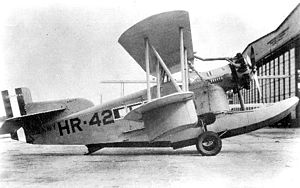| C-2 Air Yacht | |
|---|---|

| |
| One of the XHL-1s | |
| Role | Amphibious airlinerType of aircraft |
| National origin | United States |
| Manufacturer | Loening |
| Designer | Grover Loening |
| First flight | 1928 |
| Number built | 36 |
The Loening C-2 Air Yacht was an amphibious airliner produced in the United States at the end of the 1920s, developed from the OL observation aircraft the firm was producing for the US military.
Design and development
The C-2 was a two-bay biplane of unconventional design, with a tall, narrow fuselage that nearly filled the interplane gap. The pilot (and sometimes one passenger) sat in an open cockpit at the top of the fuselage, with the engine mounted in front of them. Underneath the fuselage was a long "shoehorn"-style float, that extended forward underneath the engine and propeller. Four to six passengers could be accommodated in a fully enclosed cabin within the fuselage. The main units of the undercarriage retracted into wells in the sides of the fuselage. Stabilising floats were fitted against the undersides of the lower wing.
The C-2 was produced in two versions, the C-2C with a Wright Cyclone engine and the C-2H with a Pratt & Whitney Hornet. Two examples of this latter version were evaluated by the USMC as air ambulances under the designation XHL-1.
Operational history
One C-2C, modified from an OL, was flown from New York City to Bergen by Thor Solberg in 1935, the first flight from the United States to Norway. Solberg christened the aircraft Leiv Eiriksson and used it to roughly re-trace its namesake's journey across the Atlantic (albeit from West-to-East, and by air) via Greenland, Iceland, and the Faroe Islands. This aircraft is now preserved in the Norsk Teknisk Museum in Oslo.
Two C-2Hs were also used by the firm Air Ferries in the 1930s before the San Francisco–Oakland Bay Bridge was completed to transport passengers between Oakland and San Francisco, cutting a normal forty-minute ferry boat ride to just six minutes.
The first commercial flights in Aruba were made in 1934 using a C-2H which had been purchased from Standard Oil in Venezuela.
Variants
- C-2C - Wright Cyclone-powered version (23 built)
- C-2H - (USN designation XHL) Pratt & Whitney Hornet-powered version (13 built, plus one converted from C-2C.
Operators
Civilian operators
- Kohler Aviation Corporation
- Air Ferries Ltd
Military operators
Specifications (C-2H)

General characteristics
- Crew: One pilot
- Capacity: 7 passengers
- Length: 34 ft 8 in (10.57 m)
- Wingspan: 45 ft 0 in (13.72 m)
- Wing area: 504 sq ft (46.8 m)
- Gross weight: 5,800 lb (2,640 kg)
- Powerplant: 1 × Pratt & Whitney Hornet , 525 hp (390 kW)
Performance
- Maximum speed: 120 mph (190 km/h, 100 kn)
- Service ceiling: 14,000 ft (4,300 m)
References
- ^ "The Loening Cabin Amphibian", 415
- ^ Aerofiles
- ^ "Highlights from the exhibitions in The Norwegian Museum of Science and Technology, Oslo"
- "Special Pier for Air Ferry Speeds Bay Traffic" Popular Mechanics Monthly, July 1930
- "Airport History". Retrieved 16 September 2017.
- "Flying the Bridge Across Lake Michigan". Retrieved 21 December 2020.
- "Special Pier for Air Ferry Speeds Bay Traffic" Popular Mechanics Monthly, July 1930
- "The short history of San Francisco's coolest commute". Retrieved 21 December 2020.
External links
- "Loening". Aerofiles. Retrieved 2008-10-15.
- "Highlights from the exhibitions in The Norwegian Museum of Science and Technology, Oslo". Norsk Teknisk Museum website. Retrieved 2008-10-15.
- "The Loening Cabin Amphibian". Flight: 415–17. 7 June 1928. Retrieved 2008-10-15. (This article actually describes the C-2's immediate predecessor, the Wasp-engined Loening C-1.)
| Loening aircraft | |
|---|---|
| Company designations | |
| Fighters | |
| Air Ambulance | |
| Observation | |
| Racer | |
| Army Seaplane | |
| Submarine-based Scouts | |
| USN hospital aircraft designations pre-1962 | |
|---|---|
| Piper | |
| Loening | |